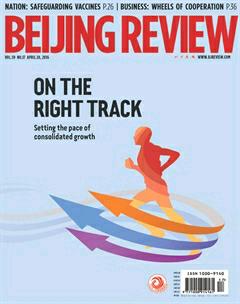A Route for Asia-Europe Financial Cooperation
2016-05-04ZhangMonan
A Route for Asia-Europe Financial Cooperation
As hosts to the world’s major economies and to the origins of Eastern and Western civilizations, Asia and Europe are the main forces in maintaining world peace, boosting joint development and promoting human progress. Promoting increased financial cooperation between Asia and Europe is pivotal to secure a robust economic recovery and create new vitality for economic growth in both regions.
Such a collaboration would reduce financing costs, improve the overall efficiency of their financial systems and create more favorable conditions for expanding trade and investment between Asia and Europe. It can also provide a powerful and efficient investment and financing guarantee to China’s Belt and Road Initiative, the European Commission’s Investment Plan for Europe, known as the “Juncker Plan,” the United Kingdom’s Northern Powerhouse and other development plans.
After expanding the use of the yuan in Asia, China is also promoting crossborder settlement of its currency in Europe. According to the Cross-Border RMB Index released by the Bank of China, as early as in May 2014, Germany and the UK both saw their respective cross-border yuan settlements with the Chinese mainland exceed 100 billion yuan ($15.5 billion). In addition, the combined cross-border yuan settlement of Germany, the UK, Luxembourg and France accounted for 8 percent of the cross-border transaction volume of the yuan.
Since 2014 China has signed yuan settlement agreements with the UK, Germany, Luxembourg, France and Switzerland. By now five offshore yuan centers have been established in Europe: London, Frankfurt, Luxembourg, Paris and Zurich.
On the other hand, a yuan currency swap network covering the whole of Europe is being formed. After regional economic and trade alliances are created, regional financial and monetary alliances are also established, represented by currency swap networks. Especially after the fallout that resulted from the U.S. subprime mortgage crisis in 2008, which spread throughout countries and regions worldwide, the central banks of many countries have signed currency swap agreements more frequently to mitigate risks. Such a financial structure based on currency swap networks is becoming a global trend.
Since 2014 China’s central bank has signed currency swap agreements with New Zealand, Mongolia, Argentina, Switzerland, Sri Lanka, South Korea, Russia and Thailand, with a total volume of 850 billion yuan ($131.17 billion). Since 2008, China has signed currency swap agreements with 28 countries, with a total volume of 3 trillion yuan ($462.96 billion).
Signing currency swap agreements is an important step for the internationalization of the yuan. To make the yuan an international currency, China will be more active in setting up a capital pool for yuan swaps to prevent external risks.
In recent years a large amount of financial resources have accumulated in Asia. Two thirds of the world’s foreign exchange reserves are in China, but most of them are dollar assets with low yields. Researches show that from 1952 to 2014, the average yield rate of foreign assets held by U.S. investors was 5.72 percent, while that of U.S. assets held by foreign investors was only 3.61 percent.
Such a gap is due to both the low risk of dollar assets and the valuation effects caused by the depreciation of the dollar against other currencies. The scale of sovereign wealth funds in Asia and Asia-Europe is enormous. In the future, Asia and Europe must reform their investment and financing mechanisms to smooth the channels for sovereign wealth funds and promote cross-border mutual investment.
After the UK, France, Germany and Italy joined the China-initiated Asian Infrastructure Investment Bank (AIIB), China also joined the European Bank for Reconstruction and Development (EBRD) on December 14, 2015, which will undoubtedly expand its investment channels and cooperation opportunities in Europe. The EBRD and the Belt and Road Initiative both focus on infrastructure investment and will generate numerous opportunities for collaboration in Central Asia.
Financing platforms alone won’t be enough to secure the success of the Belt and Road Initiative. While carrying out multilateral financial cooperation featuring syndicated loans and bank credit, China and Europe also need appropriate and workable financing tools. Bond financing is the tool best suited to infrastructure investment, since it can create new avenues for managing debt.
These measures will provide new ideas and opportunities to promote the development of the Asian bond market. Meanwhile, new development financial institutions represented by the AIIB and the New Development Bank of the BRICS (Brazil, Russia, India, China and South Africa) are also the most suitable candidates to boost the development of the Asia-Europe bond market.
In the future, Asia and Europe will have additional room for financial cooperation. They can carry out investment and financing cooperation through various forms and channels by setting up more financial institutions and promoting the connectivity of capital markets. These actions are necessary in order to build a great financial market system connecting Eurasian economies.
This is an edited excerpt of an article by Zhang Monan, an associate research fellow at the China Center for
International Economic Exchanges, published in the
Securities Times
Copyedited by Bryan Michael Galvan
Comments to yushujun@bjreview.com
